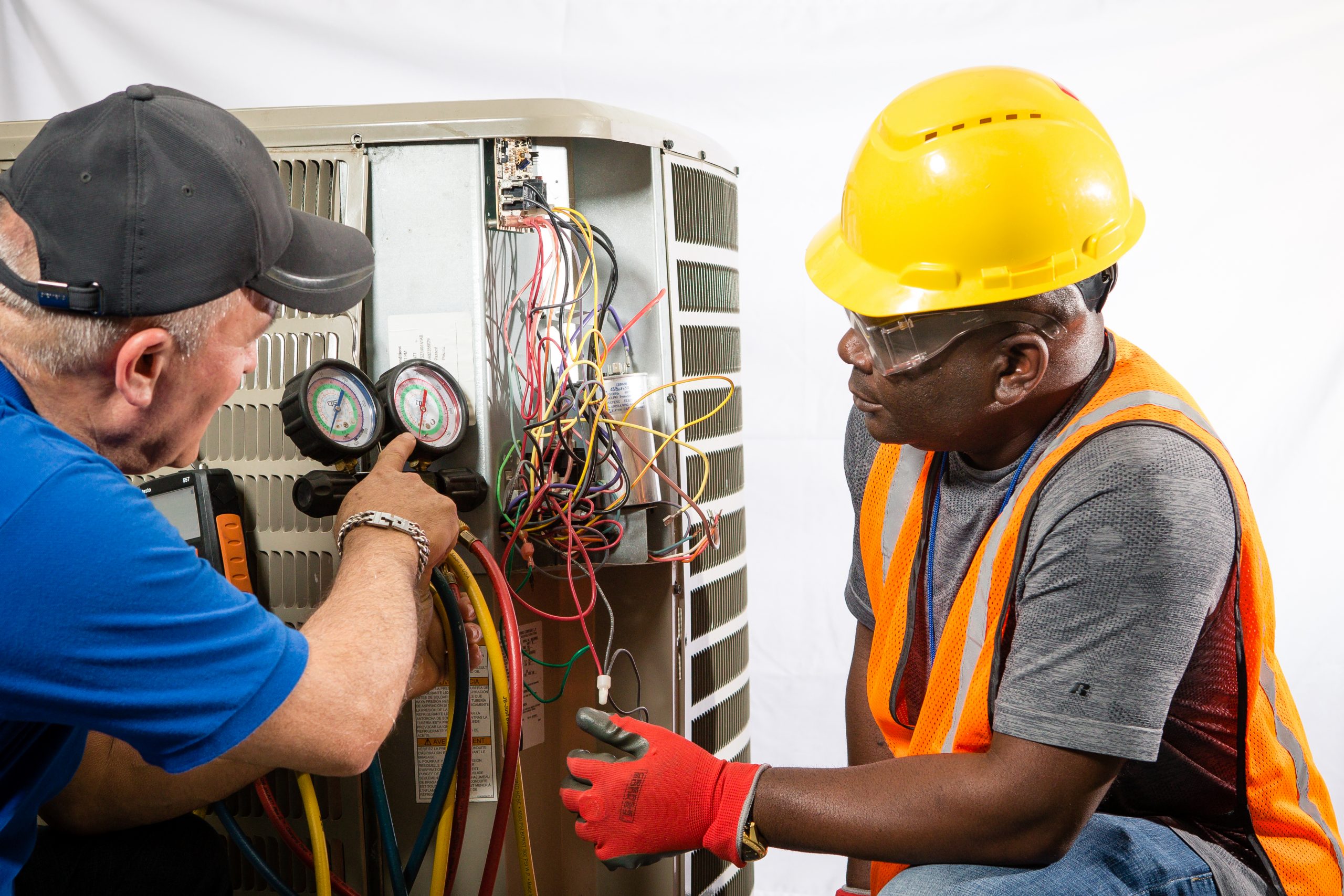Becoming an HVAC contractor in Texas is a solid career path. For many, the dream is to eventually stop working for someone else and own your own HVAC business. HVAC professionals have a wide range of employment opportunities and are well-paid. Plus, there's job security. Qualified professionals are always in demand installing and maintaining heating and cooling systems in homes and businesses. The systems that heat, ventilate and cool our homes and businesses are complicated and increasingly technologically advanced. Learning how to design, install and service them can lead to a fulfilling career with lots of earning potential.
Heating, ventilation, refrigeration, and air conditioning systems wear out over time, so there is always a need for a mechanic who knows how to repair them or install a new system. As energy efficiency and pollution reduction drive increase, mechanical systems must be retrofitted, upgraded, or replaced to meet demand.
According to the U.S. Bureau of Labor Statistics, approximately 31,000 heating, air conditioning, refrigeration mechanics and installers are working in Texas. Nationally, the number of HVAC specialists is projected to grow by 5% before 2030. In Texas, the growth rate is expected to be more than triple that figure. The BLS's job search website project the growth rate in the Lone Star State to be 16% for HVAC professionals.
Only licensed ACR contractors can operate a business and advertise their services, obtain commercial insurance, obtain building permits, and pass inspections and bids for public and government projects.
Licensing requirements for HVAC contractors vary from state to state – and sometimes from locality to locality. To perform heating, air conditioning, and refrigeration work in Texas, you must be a licensed contractor or a registered or certified technician working under a licensed contractor.
There are a few steps involved in attaining your HVAC license in Texas. You must:
- Be at least 18 years old
- Register with the state of Texas as a technician working for a contractor
- Get work experience under the supervision of a Texas-licensed contractor
- Get certified (optional or additional work experience)
- Apply for a license
- Pass the ACR contractor exam
After 24 months on the job under the supervision of a licensed contractor, Texas HVAC technicians have the option to become certified air-conditioning and refrigeration technicians by completing the 2,000-hour certification program and paying an application fee. Many institutions, including Austin Career Institute, offer air-conditioning and refrigeration certification training programs. However, individuals wanting to obtain a certified technician license should ensure that the TDLR approves them before enrolling in any program.
Those not interested in becoming certified can complete 48 months of work site experience under the supervision of a licensed contractor before applying for their contractor license.
Once you meet the work experience requirements, you can apply for a Texas air-conditioning and refrigeration (ACR) contractor license. You must be at least 18 years old to apply.
State law requires you to maintain business general liability insurance for the duration of your license and to provide proof of coverage after you pass your license exam. The license category and endorsement you choose determine the work you can perform, the license exam you take, and the insurance coverage you must maintain.
Texas has different types of HVAC licenses you can earn: Class A or Class B. A Class A contractor license allows you to work on any size unit. A Class B license will enable you to work on refrigeration systems up to 25 tons and heating systems of 1.5 million BTU per hour or less.
Three endorsements – or certifications – are available to add to your ACR license. Each license can have only one endorsement. The three endorsements are:
Commercial Refrigeration
A commercial refrigeration endorsement includes using absorption or mechanical equipment to maintain temperature or humidity in a designated space. This endorsement is restricted to coolers, freezers, ice machines, and other humidity and temperature control equipment.
Environmental Air Conditioning
This certification comprises the treatment of the air to control temperature, ventilation, circulation, humidity, and cleanliness to meet comfort needs.
Process Heating or Cooling
This certification monitors the temperature, humidity, and cleanliness for production requirements or the proper operation of equipment. It is limited to coolers, freezers, ice machines, and gear with temperature and humidity controls.
Now that you've earned your education and experience at a reputable HVAC company, it's time to consider becoming your own boss! To start your own HVAC business, you'll need to complete a few more essential steps:
Establish Your HVAC Business
The first step to starting your HVAC is registering, licensing, and ensuring your venture. Pick your business name and register it with your local government. Once you've determined the name of your business, you'll need to decide if you will proceed with a sole proprietorship or a partnership. If you are concerned about liability, incorporate your business into an LLC. This protects your private assets in the event of legal issues.
You must also get a business license and renew it every year. This ensures that you are operating within local laws and regulations. After getting a small business license, you can get a business tax number, which will help your business keep going and avoid problems when you get audited.
HVAC work can be dangerous, so purchase the correct type of business insurance to protect your business and customers. Then discuss with your insurance provider what coverage you need for your HVAC services.
Fund Your HVAC Business
Starting an HVAC business typically costs $3,000-$12,000, depending on how much equipment you need to buy upfront. If you need a truck, this cost will be higher. Once you have a starting budget, you should apply for a business loan or personal loan from the bank. Or you can look at federally funded programs like the Small Business Administration Grant.
Create your HVAC Services List
Decide what HVAC service you want to offer so you can buy the right tools and start pricing. If you focused on one service in trade school, it's probably the one you most want to sell. To make your work more rewarding, provide what you're good at -- and love to do. Here are the most common HVAC services you can provide:
- Air conditioning installation
- Air conditioning repair and maintenance
- Air duct cleaning
- Furnace installation
- Furnace repair and maintenance
- Heat pump installation
- Tankless water heater installation
- Emergency HVAC services
To run a successful HVAC business, you need to establish prices that will cover your expenses and make your business profitable. To start pricing HVAC jobs:
- Research your competitors to find out the average costs in your area
- Identify markups needed to meet profit margin targets
- Find out what optional services you can offer to increase your overall listing price
- Hourly rates: Hourly rates can help you get more value from time-consuming or commercial HVAC contracts. They're also helpful when you are unsure how long your order will take.
- Flat-rate pricing: Flat-rate pricing allows you to set a predictable price for the whole job. This pricing works well when you know how long the job will take. (For example, air conditioning repairs are $325.)
- Labor and materials pricing: When pricing installations, it's often best to charge customers based on your work and the equipment you provide. This pricing makes it easier to cover your operating costs.
Promote Your HVAC Business
Marketing is critical to getting your first customers and running a successful HVAC business. Here's what it takes to attract new customers with HLK marketing:
- Branding: Company branding gives your business a look and personality - it shows any potential customer that you are a professional. Create logos and choose corporate colors for your business cards, HVAC website designs, uniforms, and all marketing materials.
- Build a website: An online business means customers can easily find your business online. The more your business appears online (including on your website, social media profiles, and Google Local services ads and directories), the more likely people are to book with your services.
- Pound the Pavement: New HVAC entrepreneurs often use word of mouth to promote their businesses. Try getting your first HVAC lead by knocking on the door and leaving a flyer or business card.
Hire More Staff
When your business volume exceeds your capacity, it's time to find more employees. Hiring HVAC technicians for field work frees you to focus on sales, marketing, and everything related to running and growing your business.
How to find and hire a qualified HVAC technician:
- Decide if you want to hire employees or subcontractors
- Write great job postings and share them on job sites
- Prepare questions to ask new employees before hiring them
- Check references and request a police background check
- Be prepared to train employees after onboarding
- Pay your team competitive wages and provide a great work environment.


